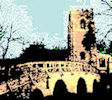Medbourne War Memorial
... and the men it commemorates
Contents
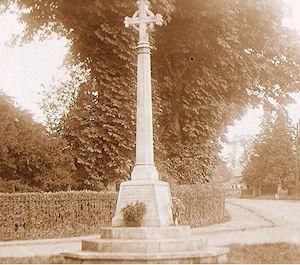
An early photo of the War Memorial
- Introduction
- The War Memorial
- World War I
- Casualties
- Links to the individual descriptions:
Herbert Aldwinkle
William James Aldwinkle
Arthur Victor Bunning
Harold Burrows
Harvey Burrows
John Thomas Burrows
Arthur Henry Gilmore
Henry William Jeffs
Charles Henry Major
Herbert Phipps Martin
Humphrey Kaye Bonney Nevinson
Frank Alex Reading
Walter Rigby
Christopher Frost Searcy
Albert Simkin
Leonard Joseph Stokes
Thomas Alfred Timson
Ernest Harold Ward
Frank Ward
- Links to the individual descriptions:
- Those who survived World War I
- World War II Casualties
- Links to individual descriptions:
William James Hilliam
Leslie Bernard Ward
- Links to individual descriptions:
- Memorial Refurbishment
- Acknowledgements
Introduction
August 4th 2014 sees the 100th anniversary of Britain joining World War I and this page is published to mark that anniversary. It is intended to be a poignant tribute to the memory of the nineteen men from the village who lost their lives in that conflict and the two men who were killed in World War II. The article is not intended to relate to the actual wars but to the human story of the names on the War Memorial.
The War Memorial
The Memorial is located in the centre of village at the main crossroads in front of the church, but outside of the church grounds. It is constructed from Weldon stone set on a Clipsham stone base by Marlow and Sons of Hallaton, the cost having been met by public subscription and donations.
There are 4 panels on which the names of 19 men are engraved from the Great War and a further 2 around the plinth from the Second World War.
The unveiling ceremony was held on Saturday 31st July 1920 and performed by Sir Keith Fraser M.P. and assisted by Reverend A. Harper of Great Easton and Reverend T. K. Nevinson of Medbourne.
The Memorial carries the following inscription:
TO THE GLORY OF GOD
AND IN MEMORY OF THOSE
FROM MEDBOURNE AND HOLT
WHO GAVE THEIR LIVES
FOR THEIR COUNTRY
IN THE GREAT WAR
1914-1918
FAITHFUL UNTO DEATH
ALSO THOSE WHO FELL IN THE WAR 1939-1945
World War I
Readers may want to contextualise references to battles and events in the descriptions of the Medbourne casualties below. World War I (The Great War) has a large volume of documented history on the internet; rather than repeat that here, we provide a reference to one comprehensive site for the war, see http://www.firstworldwar.com/index.htm.
Casualties
All of the nineteen men that appear on the memorial have been researched and information in some form has been obtained. This work has shown that the majority of the men lost their lives on the Western Front, several others died in England and one was killed in action during the Gallipoli Campaign in Turkey. Some died as a direct result of combat during the Allied and German offensives, others succumbed to disease and one died in captivity in a prisoner of war camp in Germany. There is one name for whom we have been unable to identify the nature of his death or where he is buried.
As we stop and read the names on the war memorial there are some that will sound familiar, as they should; Burrows, Ward, Simkin and Stokes are all local families whose descendants still live in, or close to the village. Other names may be less reminiscent, as their relationship with Medbourne and the valley has faded with time.
Preserved Service Records show that many of the pre-war professions of the men were farm labourers and associated with agriculture. As enlisted men the ranks of most of the names remembered were mostly Privates however there is one commissioned officer and two Sergeants. The records show that one soldier was awarded two gallantry medals, the Distinguished Conduct Medal (DCM) and the Military Medal (MM), however only the MM has been confirmed.
Not all of the remembered soldiers joined the Leicestershire Regiment; in fact there is a diverse number that also includes the Coldstream Guards, the Royal Artillery, the West Yorkshire Regiment, the Royal West Kent Regiment, the East Surrey Regiment, the East Lancashire Regiment, the Lincolnshire Regiment, the Border Regiment, the Manchesters, the Labour Corps, the Royal Army Medical Corps and the South African Infantry.
Of the 18 men about whose deaths we have certainty, two of them rest in Medbourne's churchyard, there is an inscription for another on a family headstone and a plaque inside the church for another. Two others are buried in other churchyards in England. Fourteen of the men are buried overseas; a total of 8 lay at rest in graves with headstone markers and 6 are inscribed on memorials to the fallen that have no known grave. For the 19th name we know the year and quarter when he died but not the manner of his death, or where he is buried.
What follows are individual descriptions of the 19 men named on the War Memorial. Below each name is shown their Service Number as a hyperlink; clicking this link will bring up that person's Commonwealth War Graves Commission record which, in turn, links to their CWGC certificate.
Readers may have more information to contribute to these descriptions; if so, please contact the site administrator.
Aldwinckle, Herbert
Service number R/28401
Born in 1890 the son of James and Harriet Aldwinkle of Old Holt Yard, Medbourne; he was the brother of William James Aldwinkle and, prior to joining the army, he was a farm labourer. He attested and was accepted into the army in 1909. In 1915 he married Jessie Seagrave in Woolwich. At the time of his death he was a Private in the Army Service Corps and his service record reports him as having died of peritonitis following appendicitis in hospital in Kent on the 29th July 1916; he is buried in Greenwich Cemetery.
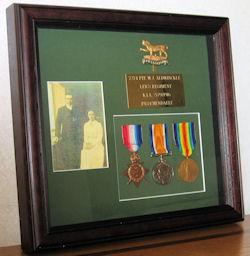
W. J. Aldwinkle: Photograph and
Campaign Medals (Pip, Squeak
and Wilfred).
Aldwinckle, William James
Service number I/7274
Born in 1885 and the brother of Herbert Aldwinkle. A Private in the Leicestershire Regiment, a professional soldier he joined the Army in 1905. His service record indicates that he was previously a farm labourer like his brother, was five feet three inches tall and weighed nine stone three pounds. He was involved in the Battle of the Somme, the infamous 1916 Allied Offensive in France. He died probably close to the village of Epehy on the 27th September 1916; he has no known grave and is commemorated on the Thiepval Memorial in France.
Bunning, Arthur Victor
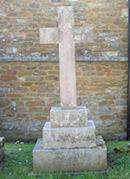
A.V. Bunning's
headstone.
Service number 15880
Born in 1889, Arthur was the son of Thomas and Ann Bunning of Medbourne. He appears to have emigrated to South Africa where in May 1917 he was working as a salesman. On the 29th May 1917 in Durban he enlisted in to the Second South African Regiment at the age of twenty eight.
He set sail for England on the ship HMT Ulysses from Cape Town on the 26th June 1917; records show him in England on the 31st July. He would appear to have taken ill, possibly on the voyage, as he died of pneumonia in Woking Hospital on the 5th August 1917 at 12:30 a.m., forty eight hours after being admitted to hospital. As a result he did not join the theatre of war and is buried in St. Giles' churchyard, Medbourne, see photo left.
Burrows, Harold
Service number 25082
Born in 1892, the son of Ann Burrows, he was a Private in the Leicestershire Regiment. In 1917 he took ill and was moved back from the front to a large hospital complex in Boulogne awaiting repatriation to England. However, he died on 9th May 1917 and was buried in the Boulogne Eastern Cemetery.
Burrows, Harvey
Service number 64499
Born in 1897 the son of James and Rose Ellen Burrows of Bonsor's Yard, Medbourne. He served in the 102nd Field Ambulance Unit of the Royal Army Medical Corps. Little is known about his military career but his death, aged 21, was registered in Leicester in the third quarter of 1918. This would seem to indicate that he was wounded and repatriated to England but died of his injuries in hospital in Leicester. There is no entry in Medbourne Church records of his interment and no other burial record has been traced. Also, there is no Commonwealth War Graves Commission record for him, hence his Service Number, above, has no link.
Burrows, John Thomas
Service number 7759
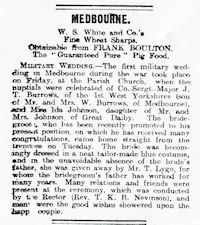
J.T. Burrows wedding
announcement
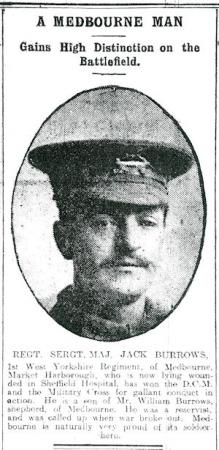
J. T. Burrows:
Midland Mail article
Born in 1884, the son of William and Ann Burrows of Crain's Yard, Medbourne, he was the husband of Alice Ida May Burrows. They were married at Medbourne Church by the Reverend T. K. B. Nevinson whilst John was on leave from active service, (see newspaper report right). A Sergeant Major in the West Yorkshire Regiment (Prince of Wales Own) he was awarded the Military Medal (Gazetted 19th November 1917), the Distinguished Conduct Medal and the Military Cross (not traced).
The Midland Mail (see left) reported him wounded and recovering in Sheffield Hospital on the 14th July 1916. The opening day of the Battle of the Somme was the 1st of July 1916 and his regiment was involved in the initial attacks and heavy fighting at Thiepval Wood.
He was killed in action the following year on the 27th May 1917 and is buried in the Nine Elms British Cemetery in Belgium which was a casualty clearing station for the wounded during the battle of Ypres. It is likely his Military Medal was awarded to him for action during the Ypres allied offensive.
Gilmore, Arthur Henry
Service number 29768
Born in 1888 in Walkden in Lancashire, by 1901 he was living in Main Street Medbourne with his grandparents John and Hannah Driver. A Private in the West Yorkshire Regiment (Prince of Wales Own) he was taking part in the opening days of the 2nd Battle of Arras and died on the 6th May 1917 being buried in the Valencienes (St. Roch) Communal Cemetery in France.
Jeffs, Henry William
Service number 25098
Born in 1890 the son of Thomas and Isabella Jeffs of Queens Head Yard Medbourne, he was a Private in the Leicestershire Regiment. He was twenty five when he enlisted on the 3rd of December 1915 at Market Harborough. His previous profession had been as a shepherd.
Taking part in one of the phases of the Battle of the Somme he was killed on the 15th September 1916 and has no marked grave but is commemorated on the Thiepval Memorial in France.
Major, Charles Henry
Service number 14725
Born in 1893 the son of Joseph and Zelinda Major of Main Street, Medbourne; in the 1901 census his father was listed as an innkeeper at the Crown Inn. He is described as being five foot ten inches tall with light brown hair and blue eyes when he signed up to the Leicestershire Regiment at the age of twenty two in 1914. His service record shows he disembarked in France on the 29th July 1915 and was promoted to Sergeant on the 25th September 1916. His record also shows he suffered two bouts of scabies while in the trenches. He was declared missing on the 27th May 1918 and, sometime later, declared dead on that day. He was killed whilst involved in the efforts to repel the so-called German Ludendorff Offensive. His body was never recovered and he is commemorated on the Soissons Memorial in France. Of the men honoured on the war memorial he was the last of the nineteen to be killed on the actual battlefield in World War I.
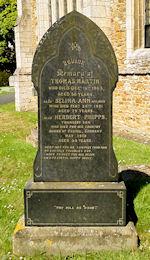
Martin family headstone
St. Giles' churchyard
Martin, Herbert Phipps
Service number 20298
Born in 1885 the son of Thomas and Selina Martin of Hall Lane, Medbourne, he married Grace Marlow in 1916. A Private in the Coldstream Guards he was taken prisoner in March 1918 and kept in a Cassel (Kassel) Prison Camp housing some twenty thousand persons who were made to work in factories mainly producing munitions. He died in the camp on the 17th May 1918 at the age of thirty four and is buried in the Niederzwehren Cemetery in Germany. He has an inscription on his family's gravestone in St. Giles' Church, Medbourne.
Martin H. P.: Entry of death in Regimental Register.
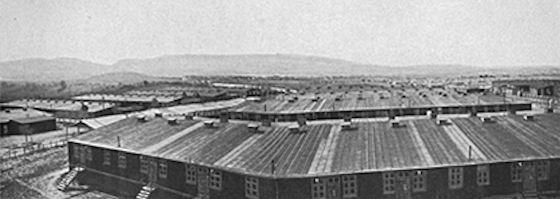
Cassel (Kassel) Camp, Germany where H.P. Martin died.
Nevinson, Humphrey Kaye Bonney
Service number unknown
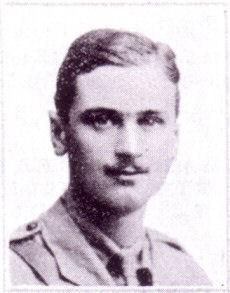
H.K.B. Nevinson
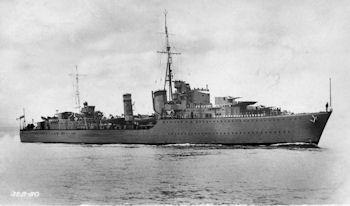
HMS Somali
Born in 1891 at Lyndon in Rutland he was the son of Reverend T. K. B. Nevinson and Ethel Nevinson of the Rectory, Medbourne; and nephew of the famous Great War artist Christopher Richard Wynne Nevinson. He attended Oakham Grammar School and then entered into a career at a brewery starting in Stamford moving to Wrexham and then Oldham. While at Oldham he took a captaincy in the Church Lads Brigade.
He took a commission as a Second Lieutenant in the 10th Manchester Regiment in March 1914 (Gazetted 15th May 1914) several months before war broke out. In Autumn of that year he sailed for Egypt to protect the Suez Canal and in May 1915 sailed for Gallipoli where he had his first action on May 16th.
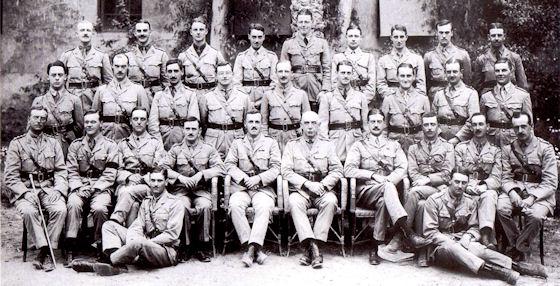
The officers of Nevinson's battalion in Egypt a few weeks before they left for
Gallipoli.
Nevinson is seated on the floor, front left.
His Battalion took part in the third battle of Krithia in the Gallipoli campaign; he was wounded in the thigh on the 4th June 1915 and was moved to HMS Somali (see right) which was lying offshore. However, he died the next day and was buried at sea, being commemorated on the Helles Memorial in Turkey.
He wrote several letters to his family and indeed wrote a very matter-of-fact letter the morning of the Krithia attack. This letter was handed to Corporal William Parker who aided Nevinson after he was wounded. During the research a letter from Lance Corporal William Parker addressed to Nevinson's parents was found. Despite the odd end to the letter it offers a rare personal eye witness account of the attack and Allied military tactics used at that time.
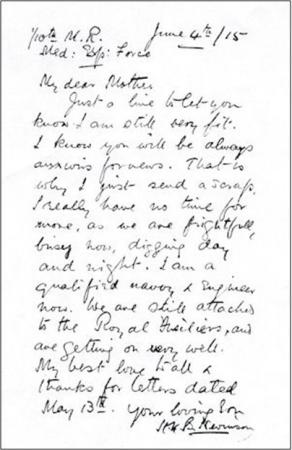
Nevinson's letter home, written
on the day he was wounded.
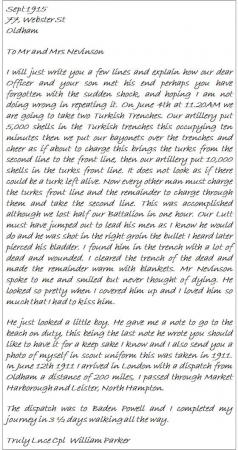
Lance Corporal Parker's letter
to Nevinson's family.
Nevinson's death was reported in the newspaper on the 2nd July 1915. His father assisted in the unveiling ceremony of the Medbourne War Memorial in 1920 and there is an ornate plaque commemorating him in St. Giles' Church.
Reading, Frank Alex
Service number 265947
He was born in 1896 the son of John and Elizabeth Reading of Main Street, Medbourne. A Private in the Lincolnshire Regiment, taking part in the Battle of Bapaume he is likely to have died of his wounds on the 4th April 1918 and is buried in the Etaples Military Cemetery in France. During the First World War, the area around Etaples was the scene of immense concentrations of Commonwealth reinforcement camps and hospitals.
Rigby, Walter
Service number 367216
Born in 1899 the son of John and Ann Rigby of Hall Lane, Medbourne, one of eight children he had a twin sister Ethel. A Private in the Labour Corps he died on the 8th November 1918 three days before the Armistice was signed. He his buried in Carlton Cemetery Nottinghamshire, which would indicate that he had been repatriated at some time to England and transferred to the Labour Corps and later died of his wound, e.g. mild injury, gas, or other circumstances.
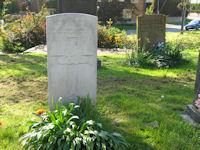
C.F. Searcy: Commonwealth
War Graves headstone in
St. Giles' churchyard.
Searcy, Christopher Frost
Service number TRS/13024
Born in 1892 the son of George and Caroline Searcy of Searcy Yard, Medbourne, he married Margaret Howard in 1915. In October 1916 he joined the Training Reserve Battalion at Rugeley Camp in Staffordshire but during his training he contracted pneumonia and as a result sadly died on December 16th 1916 and is buried in Medbourne churchyard, see right.
Simkin, Albert
Service number 457085
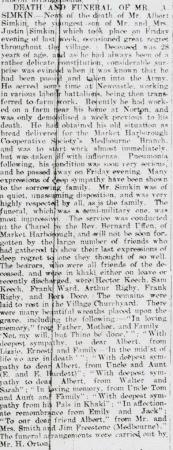
Press account of the
death and funeral of
Albert Simkin
Born in Hallaton in 1891 Albert was the son of Justin and Priscilla Simkin, but by the time of the 1911 census the family were living in Victoria Cottages, Medbourne. He was described as having a delicate constitution and on joining the army entered the Labour Corps a non-combatant corps manned by men who were not ill but were not A1 medically fit for active duty; they nevertheless played a vital role in the war effort.
He was originally stationed in the Newcastle area but later was sent to work on a farm at East Norton. At the start of 1919 he was still in the army but was demobilised in early February and was due to take up employment with the Market Harborough Co-operative Society at their premises in Medbourne. Sadly he contracted influenza which turned into pneumonia and he died only a week after leaving the army. A semi-military funeral was held for him and he was buried in Medbourne churchyard, although there is no known gravestone.
The 1918 flu pandemic was one of the most deadly natural disasters in human history, estimated at infecting over 500 million people worldwide it claimed between 50 and 100 million lives which equated to between 3 and 5% of the world population at the time.
The press cutting (right), from the Market Harborough Advertiser, gives an account of Albert Simkin's death and his funeral.
Stokes, Leonard Joseph
Service number 3082
Born in 1897 the son of Thomas and Constance Stokes, the family came from Hallaton. A Private in the East Surrey Regiment he disembarked in France on the 23rd February 1915. He died one month later on the 29th March 1915 and is buried in the Voormezeele Enclosure No. 3 near Ypres in Belgium. Of the men honoured on the Medbourne War Memorial he was the first fatality of the war.
Timson, Thomas Alfred
Service number 235648
Born in 1896 and believed to be the son of Sarah Timson, in the 1901 census was living at 10, Westhorpe, Ashley with his mother and his grandfather Thomas Timson. Originally a Private in the Manchester Regiment he later transferred to the East Lancashire Regiment. He died on the 25th April 1918 and is buried in the Blangy-Tronville Communal Cemetery in France.
Ward, Ernest Harold
Service number Gr/15366
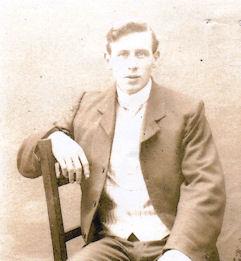
E.H. Ward before the war.
Born at Ashley in 1888 the son of Frederick and Phoebe Rose Ward, in the 1911 census the family was listed as living in Main Street, Medbourne; his parents had five children one of whom was Frank Ward. He was a gardener and, aged 27, he was married to Gertrude Laker of Reigate, Surrey; they had one child and lived at 75 Homesdale Road, Reigate. Ernest was twenty eight when he enlisted.
A Private in the Queen's Own (Royal West Kent) Regiment he has an interesting Service record. The record reports he suffered from German measles on the 23rd March 1917 and on the 13th June 1917 received a gunshot wound to the face, but returned to active duty on the 23rd June 1917.
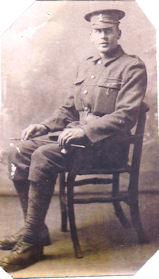
E.H. Ward in the
uniform of the
Royal West Kent
Regiment.
His record reports show conflicting information regarding the date he was killed in action; it shows him killed on the 3rd August and also on the 31st July; the latter coincides with the Commonwealth War Graves Commission and also his death certificate, so is believed to be the correct date. He was 29 when he died. The 31st July was the opening day of the Battle of Ypres. He has no known grave and is commemorated on the Ypres (Menin Gate) Memorial in Belgium.
Ward, Frank
Service number 15274
He was born in Ashley in 1892 the younger brother of Ernest Harold Ward and one of a family of five children. He was a 22-year-old Labourer when he attested in September 1914, only one month after the break out of hostilities. His service record describes him as weighing 140lbs and measuring five feet ten inches in height and having dark brown hair. A Private in the Leicestershire Regiment he died on the 17th July 1916, killed on the third day of heavy fighting in the most famous action of the Tigers Brigade who attacked and successfully captured Bazentin Ridge on the Somme.
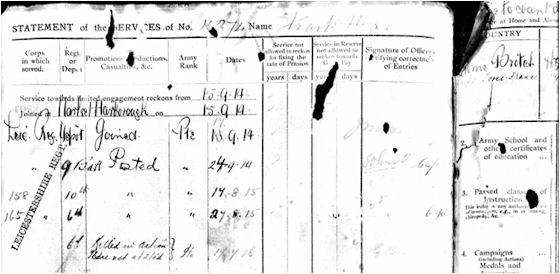
F. Ward: Extract of Service Record showing he is killed in action.
He has been recently commemorated on the 1914/1918 France Memorial which is situated near Maidenhead in Berkshire. Sometime ago, whilst looking at the War Graves Commission web site, James Royall (see Acknowledgements) noticed that Frank was not shown on their records. Following extensive investigations he was able to prove Frank's military record to the Commission and his name was subsequently added to the memorial and his details posted on the web site.
Those who survived World War I
The investigative work revealed another noteworthy group of names that deserve tribute. These are the people of Medbourne and surrounding villages who signed up voluntarily or were conscripted into the armed forces to serve in the war and returned to civilian life after the cessation of hostilities in 1918. They number 45 from a village that only had a census population of four hundred and fifty. Their names from the Absent Voters list of 1918 are given on a separate page: World War I - those who came home. This page also contains a contemporaneous account of the celebrations enjoyed by the returning men.
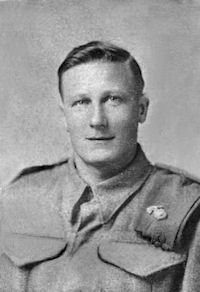
W.J. Hilliam
World War Two Casualties
Hilliam, William James
Service number 6986023
He was born in 1921 the son of Reginald James Hilliam and Ada Gertrude Hilliam of Sutton Bassett. A Fusilier in the Royal Inniskilling Fusiliers he died on the 5th December 1944 and is buried in the Santerno Valley War Cemetery in Italy.
Ward, Leslie Bernard
Service number 4868505
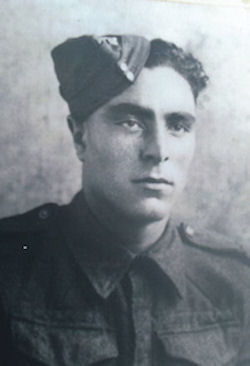
L.B. Ward
He was born in 1921 the son of Frank and Mary Ward of Medbourne. He served in the Leicestershire Regiment and died on the 28th January 1944 and is commemorated on the Cassino Memorial in Italy.
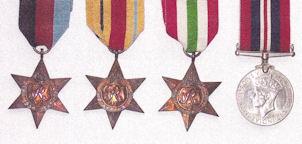
L.B. Ward Campaign Medal
Group:
1939-45 Star, Africa
Star, Italy Star,
War Medal 1939-1945
Leslie had been taken prisoner in Italy and as the Allied Armies continued their advance northwards the Germans commenced vacating the prisoner of war camps and moving the prisoners further north into Austria and Germany.
On the day of his death Leslie had just boarded a train when it was attacked by allied air forces that were under the impression that the train was carrying German Military personnel and equipment.
His medals are shown.
Memorial Refurbishment

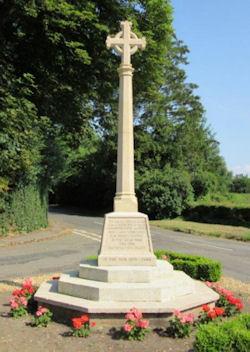
The War Memorial newly cleaned
with the lettering re-painted.
Summer 2014.
In 2014 the Parish Council were awarded a grant from the Heritage Lottery Fund to clean and re-letter the war memorial, together with three associated heritage projects, one of which is this web page. As this same year sees the 100th Anniversary of the outbreak of World War I this is a fitting tribute to the men who lost their lives in the service of their country.
Acknowledgements
This page was contributed by Keith Sandars with very considerable help from Jim Royall who, in turn, acknowledges his father, the late Christopher Richard Banyer Royall, and Rosie Burrows (nee Simkin) for their help with the research. David Tuffs contributed text and picture editing. July 2014.
If you own or would like to share more information or are interested in the content of this article don't hesitate to contact the site administrator who will pass on your request.
